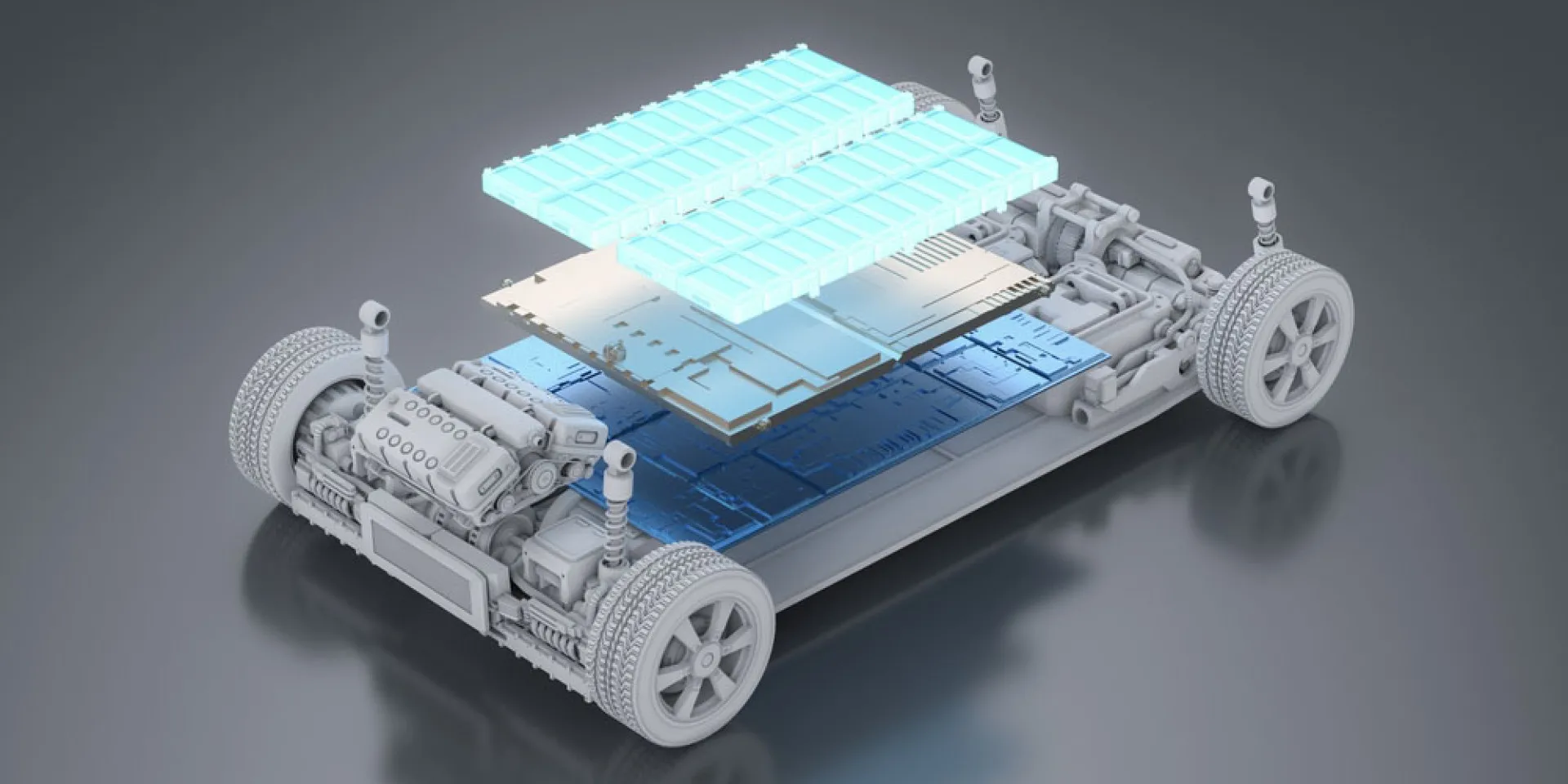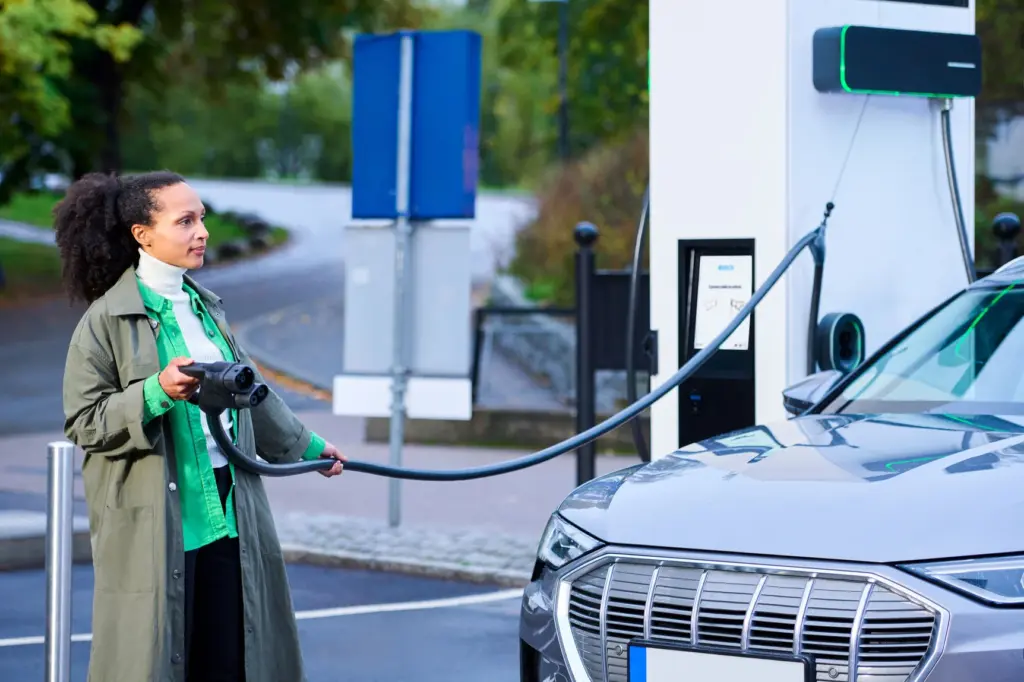Published on: 23. 11. 2023
Trading the gas tank for an EV battery
2022 was a record-breaking year for electric vehicle (EV) sales, things haven’t slowed down at all in 2023., nor are they looking to do so in the coming years. It’s clear that societies across the world are embracing electric mobility as the future of road transport.
Still, EVs remain an unfamiliar experience for many, and especially for new EV drivers the thought of swapping out the gas tank for a battery can be daunting. This guide is made to provide some clarity regarding every EV battery: its lifespan, cost, environmental impact, or even its weight. This guide will offer an overview of everything you need to know.

1. How long does an EV battery last?
By far one of the main concerns drivers have about electric cars is their battery’s longevity –in our 2022 Mobility Monitor research 33 percent of potential EV drivers stated it as an essential concern. More recently, the Green Finance Institute found that 62% of drivers who said they wouldn’t buy a second-hand EV cited concerns around battery lifespan. In addition and in that same report, the majority of dealerships recognized battery lifespan as one of the top consumer concerns in the context of used EVs.

The EV battery will outlive your electric car
EV batteries are built from the start to be resilient and durable. Currently, most electric car batteries are estimated to last between 15 and 20 years before they need replacing. By comparison, the average life expectancy of a traditional car is currently only 12 years, so EV batteries will likely outlive the vehicle they’re in.
EVs are estimated to lose an average of 2.3 percent of their battery capacity per year. In other words, if you purchase an EV today with a 240 km (150 miles) range, you’ll have only lost about 27 km (17 miles) of accessible range after five years. Overall, EVs are projected to last between 100,000 and 200,000 miles, (160,000 km – 320,000 km) before their battery needs replacing. It’s worth also remembering that most manufacturers offer an 8-year warranty or a 160,000km (100,000 mile) drive limit, so you’ll be protected against any unexpected defects or early failure.

But aren’t EV batteries made from the same material as the batteries in smartphones?
In a way, yes. But there’s more to it.
Like most consumer electronics, EV batteries use lithium-ion technology to store and release energy. Compared to other types of batteries, lithium-ion has a high energy density, meaning it can store a high amount of energy in a given weight.
But there’s more to an EV battery than just lithium-ion.
The battery in, for example, a mobile phone is consumer-grade, which means it’s optimized for maximum runtime at low cost. Also, it’s a lot smaller.

An EV battery is made to industry standards with longevity in mind. A big difference is how the energy is used.
Unlike your phone or laptop, EVs are made up of thousands of individual lithium-ion cells and they have built-in protection mechanisms to protect against aging and wear.
After a mobile phone is charged, the stored energy can be fully utilized until the battery goes empty. In other words, the user has full access to the stored energy.

Today, EVs have an advanced battery management system, commonly referred to as BMS. This intelligent system controls every aspect of battery charging and discharging, protects battery cells, and ensures you have enough range for years to come.
The BMS can set aside some capacity to protect the battery and redistribute energy to ensure cells are being used evenly. It can also adjust charging depending on the weather conditions, for example, by slowing or stopping charging completely in extremely cold or warm weather to protect battery cells.
How to extend your EV battery’s life?
Of course, like any other product, eventually, it will perform less optimally.
Although advancements in EV battery technology have increased the longevity of electric vehicles, it is important to take appropriate steps to maintain and optimize battery performance. Here are 3 handy tips to extend your EV battery’s life:
- Minimize Daily Charging: Avoid charging your EV daily to reduce battery stress.
- Maintain 20-80% Charge: Only charge 100 percent when needed for long trips.
- Manage the State of Charge for Storage: During long-term storage, maintain the battery charge between 25%-75%
Read more here
2. What are EV batteries made of?
Typically, EV batteries are made up of thousands of rechargeable lithium-ion cells connected together to form the battery pack. Besides lithium, they also contain various rare or hard-to-extract materials such as nickel, cobalt, manganese, and graphite.
While you might associate lithium-ion cells with EV batteries, there are a number of other battery chemistries that can be used to power electric cars. Nickel manganese cobalt (NMC) and nickel metal hydride (Ni-MH), for instance, were popular in the early days of electric vehicles and are still used in some hybrid models.
But even lithium-ion batteries aren’t exclusively made up of lithium. Like other batteries, lithium-ion cells have a positively charged cathode and a negatively charged anode. The former is typically made from a mix of lithium, nickel, cobalt, and manganese, while the anode is usually made of graphite.
The battery pack is contained in a steel or aluminum casing that holds the individual cells together and offers protection against mechanical damage.

Different EV battery cell types
While we tend to think of EV batteries as a single unit, in practice, they are broken down into modules, each made up of hundreds or even thousands of individual cells. These cells can take different forms, and there are three main types currently on the market.
- Cylindrical cells: Some of the cheapest and easiest to manufacture, but they can be somewhat limited in their power output compared to other types of cells.
- Prismatic cells: They require less material for the casing but can often store more energy and deliver higher power in a smaller body.
- Pouch cells: Contained in a soft plastic casing, making them highly versatile for different formats. That said, their casing is fragile on its own, requiring additional protection against mechanical shocks.
Read more here
3. How much does an EV battery cost?
The battery pack is by far the most expensive component of an EV. How much an EV battery costs depends on its size, the power it can hold, and its manufacturer. That said, on average, EV battery packs currently cost between $10,000 and $12,000.
EV batteries rely on a range of rare or difficult-to-extract metals and minerals that go beyond just Lithium. Such as nickel, cobalt, manganese, and graphite, as well as steel and aluminum for the enclosure. Sourcing these materials, especially in the quantities needed to make an EV battery, does not come cheap, and they usually account for the lion’s share of an EV battery’s cost.

Who makes EV batteries?
Around 70 percent of EV battery production is concentrated in China, with the US, Japan, and Korea also holding important shares of the market. While the US and EU are investing to increase their domestic battery production, China will likely remain the leading producer of EV batteries until at least 2030.
For example, CATL (Contemporary Amperex Technology Co. Limited), a Chinese company, holds around 34% of the total EV battery market share.
Read more here
4. Are EV batteries bad for the environment?
Whether EVs are better or worse for the environment than combustion engine cars has been debated since the first electric cars came on the market.
In a nutshell, electric cars are far better than internal combustion engine vehicles.

Make no mistake, electric vehicles and their batteries are a crucial step towards a more sustainable future in transportation, as they offer a cleaner and greener alternative to traditional combustion engine cars. On-road operation of EVs results in significantly fewer greenhouse gas emissions, with zero tailpipe emissions.
That being said, there is still an impact on the environment. The bulk of this comes from the production of the EV battery and the extraction of the raw materials needed for it. Let’s explore the environmental impact of manufacturing EV batteries.
Environmental impact of battery production
EV batteries are made of many rare and difficult-to-extract materials, aptly named rare earth elements (REE), such as lithium, cobalt, and manganese. We’ve explored the environmental impact of mining each of these materials more extensively here. Make no mistake, policymakers and industry leaders have a duty to enhance the working conditions related to the mining and production of batteries and are working on improving the entire battery production and lifecycle journey.
Billions versus millions
In one of our REVOLUTION Podcasts, we spoke to Julia Poliscanova, Senior Director of Vehicles & e-mobility Supply Chains at Transport & Environment (T&E). And asked her about mining.
“I think today, I don’t know, whenever people hear the word electric car, they probably think of a mine, which is just so unfair.” – Julia Poliscanova
Did you know that each year, we extract a staggering 15 billion tons of coal, oil, and natural gas to fuel our traditional mobility needs and current economies?
Contrast that with the critical metals essential for electric vehicles – approximately 7 million tons annually. And projections show that by 2050, even with widespread EV adoption, we’ll require 30 to 40 million tons of these materials yearly.
To put it in perspective, remember that one billion is equal to one thousand million.
But here’s the difference that maybe matters most:
The combustion engine fuel that goes into a car – the petrol, the diesel – when it’s burnt, that’s gone forever. So, the extraction of resources is a running cost.
In our podcast episode, Julia emphasized that the raw metals needed for electric mobility offer a unique advantage – they’re a capital cost. Once mined and integrated into EV technologies, they contribute to years of emission-free driving, reducing the need for constant extraction.
Of course, it’s vital to embrace a more responsible approach across the entire journey and utilize responsible recycling practices. Ethical Sourcing and Tracing are paramount. From carbon footprints to eliminating forced labor, batteries must adhere to ethical practices throughout their supply chains, extending even to mining operations.
A New law on more sustainable, circular, and safe batteries
In July of 2023, The European Parliament adopted new regulations on batteries. Strengthening sustainability rules for batteries and waste batteries. The regulation will regulate the entire life cycle of batteries – from production to reuse and recycling – and ensure that they are safe, sustainable, and competitive.
“So the idea is no matter where the battery comes from, there needs to be this digital tracing of the supply chain attached to the battery.” – Julia Poliscanova
For the first time, it ensures comprehensive environmental safeguards across the battery life cycle – from sourcing raw materials to production and recycling.
Did you know that the impact of the EU battery regulation isn’t confined to Europe alone? Batteries produced worldwide must meet stringent environmental and ethical criteria, ensuring a sustainable future for all.
The rise of LFP batteries
Luckily, EV manufacturers are increasingly moving away from materials like cobalt and looking for more sustainable alternatives. One such technology that has been gaining popularity is lithium iron phosphate (LFP or Li-FP), which replaces cobalt with iron which is non-toxic and easier to source ethically.
Many Chinese manufacturers have already embraced LFP batteries, while Western carmakers are starting to catch on as well. Tesla, for instance, already produces half of its cars with cobalt-free LFP batteries.

The environmental impact of EV batteries over their lifetime
Over their 15-20 year long lifespan, EVs will help prevent enormous amounts of greenhouse gas emissions, and a typical EV reaches parity in terms of emissions with a combustion engine car after around 33,000 km on the road.
Read more here
5. Are EV batteries recyclable?
Even with the best care and maintenance, there comes a point where EV batteries are no longer suitable for powering a car. Thankfully, there are many ways to reuse, upcycle, and recycle older EV batteries.
EV battery recycling
In fact, new techniques allow up to 95 percent of the raw materials from an EV battery to be recovered, long after it has outlived its initial life in your vehicle. To achieve this, batteries are shredded, and the remaining materials are separated either by applying heat or various chemical solutions to extract the appropriate valuable substances.
But even before recycling, an EV battery can have a second life long after the vehicle stops driving.

Repurposing and upcycling old EV batteries
While they may not be suitable for powering cars anymore, old EV batteries retain a significant proportion of their original capacity – up to 60-70 percent, according to Nissan. This opens many uses in less energy-intensive applications, such as electricity storage for a grid, home, or business.

For example, our partner, The Mobility House, has used 148 old Nissan Leaf batteries to create a 3-megawatt storage solution for Amsterdam’s Johan Cruijff ArenA, helping meet peaks in energy demand during events.
Read more here
6. How much does an EV battery weigh?
On average, EV batteries weigh around 454 kg, or 1,000 pounds. How heavy an EV and its battery depends greatly on the vehicle, with some EV batteries weighing only a few hundred kilograms while others can weigh upwards of 900 kg (2,000 pounds).
What determines the weight of an EV battery?
A typical EV battery contains 8 kilograms of lithium, 14 kilograms of cobalt, and 20 kilograms of manganese, although this can vary greatly depending on the model.
All in all, the individual battery cells make up about 60 to 75 percent of a battery’s total weight, while the remaining 25 to 40 percent is made up of the battery’s casing, cables, and thermal and battery management systems (TMS and BMS).

Impact of battery weight on driving specifications
Adding around 500 kilograms of battery weight to an EV doesn’t harm its handling, in fact,
EVs tend to be more stable and often handle better than their gas counterparts.
This added weight helps lower the car’s center of gravity, making it much more stable on slippery road conditions or tight curves. This also greatly improves passenger safety by minimizing the chance of a rollover in an accident.
Advancements in battery technology and lightweight materials
While EVs tend to be heavier than combustion engine cars on average, this isn’t necessarily going to be the case for long.
In fact, materials such as magnesium alloys, aluminum alloys, carbon fiber, and polymer composites can reduce the car’s weight by up to 50 percent, helping decrease energy consumption and boosting efficiency.
Read more here
Discover more about EV charging
Electric vehicles are a new experience for many, and compared to the well-known gas tank, EV batteries can often seem strange and unfamiliar. Whether it’s how much they cost, how heavy they are, or their environmental impact and recyclability, we hope the above has offered you a comprehensive overview of EV batteries.
If you’ve just purchased your first EV, or are considering buying one, have a look at our detailed guide to learn everything you need to know about electric vehicle charging.



![How far can an electric car go on one charge? [May 2023 updated]](https://evbox.com/app/uploads/2025/09/shutterstock_2115845192-min.webp)